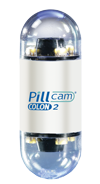FDA Down-Classifies Camera Pills, IV Set Air Purge Systems
May 20, 2014
In moves that will likely make life a bit easier for prospective makers of two types of medical devices, FDA has published Final Orders governing the classification of colon capsule imaging systems and intravascular administration set automated air removal systems that downgrade both from Class III to Class II, with the addition of special controls for both device types.
The new Final Orders will take effect on June 16. After that date, a manufacturer of either type of device will only need to prove that its device is "substantially equivalent" to an already approved device, rather than complete the more arduous Premarket Approval (PMA) process, as previously had been the case.

In the case of colon capsule imaging systems, that predicate device is Given Imaging's (Yoqneam, Israel) PillCam Colon 2 (shown here) capsule endoscopy system. Makers of IV set automated air removal systems will need to convince FDA that their prospective offerings are substantially equivalent to Anesthesia Safety Products' (Woburn, MA) AirPurge System to achieve approval by the 510(k) route.
Written to cover colon capsule imaging systems, 21 CFR Part 876 defines that device as "a prescription, single-use ingestible capsule designed to acquire video images during natural propulsion through the digestive system. It is specifically designed to visualize the colon for the detection of polyps. It is intended for use only in patients who had an incomplete optical colonoscopy with adequate preparation, and a complete evaluation of the colon was not technically possible."
Intravascular administration set automated air removal systems are those that, according to the new 21 CFR Part 880, are "a prescription device used to detect and automatically remove air from an intravascular administration set with minimal to no interruption in the flow of the intravascular fluid. The device may include an air identification mechanism, software, an air removal mechanism, tubing, apparatus to collect removed air, and safety control mechanisms to address hazardous situations."
While the special controls for each type of device are specific to that device type, the underlying principle, the mitigation of the risks and hazards peculiar to the device type to ensure a reasonable assurance of safety and effectiveness, is the same.
Stephen Levy is a contributor to Qmed and MPMN.
About the Author(s)
You May Also Like


